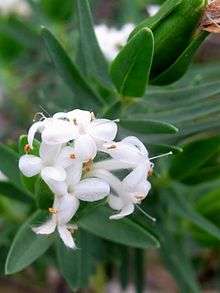Pimelea congesta
| Pimelea congesta | |
|---|---|
 | |
| Scientific classification | |
| Kingdom: | Plantae |
| (unranked): | Angiosperms |
| (unranked): | Eudicots |
| (unranked): | Rosids |
| Order: | Malvales |
| Family: | Thymelaeaceae |
| Genus: | Pimelea |
| Species: | P. congesta |
| Binomial name | |
| Pimelea congesta C.Moore & F.Muell. (1872)[1] | |
Pimelea congesta is a flowering plant in the Thymelaeaceae family. The specific epithet refers to the congested inflorescence.[1]
Description
It is a shrub growing to two metres in height, with tough, red bark. The oval leaves are 10–20 mm long, 4–6 mm wide. The terminal inflorescences contain about nine white flowers, 15 mm long, which appear from July to December. The fruits are oval brown nuts, 2–3 mm long.[1][2]
Distribution and habitat
The species is endemic to Australia’s subtropical Lord Howe Island in the Tasman Sea. There it is widespread, especially on exposed ridges. It is closely related to Pimelea longifolia of New Zealand.[1][2]
References
- 1 2 3 4 " Pimelea congesta ". Flora of Australia Online: Data derived from Flora of Australia Volume 49 (1994). Australian Biological Resources Study (ABRS). Retrieved 2014-02-23.
- 1 2 Hutton, Ian (1998). The Australian Geographic Book of Lord Howe Island. Sydney: Australian Geographic. p. 145. ISBN 1-876276-27-4.
This article is issued from Wikipedia - version of the 7/21/2016. The text is available under the Creative Commons Attribution/Share Alike but additional terms may apply for the media files.